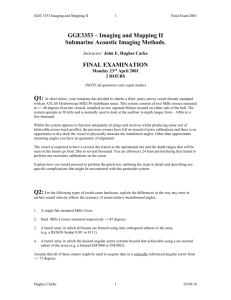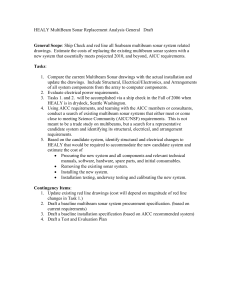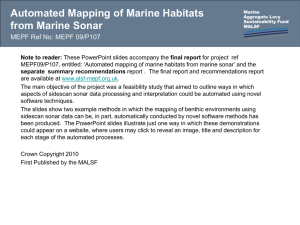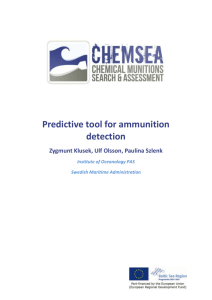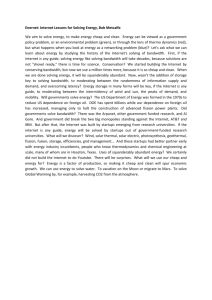Final Q`s 2004
advertisement
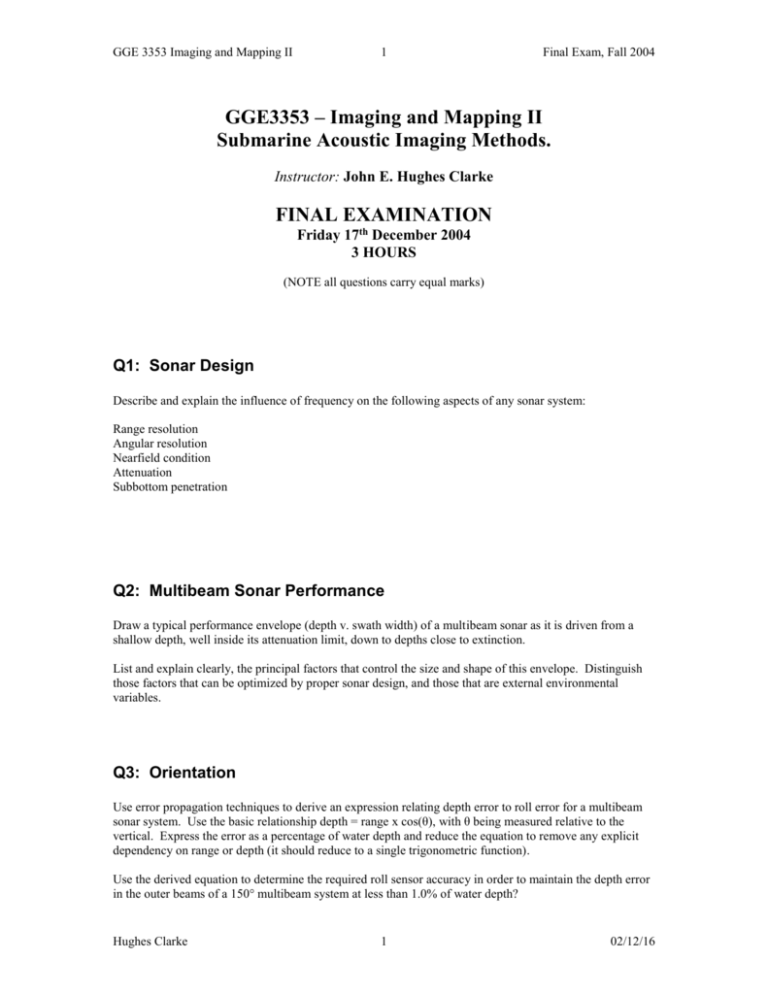
GGE 3353 Imaging and Mapping II 1 Final Exam, Fall 2004 GGE3353 – Imaging and Mapping II Submarine Acoustic Imaging Methods. Instructor: John E. Hughes Clarke FINAL EXAMINATION Friday 17th December 2004 3 HOURS (NOTE all questions carry equal marks) Q1: Sonar Design Describe and explain the influence of frequency on the following aspects of any sonar system: Range resolution Angular resolution Nearfield condition Attenuation Subbottom penetration Q2: Multibeam Sonar Performance Draw a typical performance envelope (depth v. swath width) of a multibeam sonar as it is driven from a shallow depth, well inside its attenuation limit, down to depths close to extinction. List and explain clearly, the principal factors that control the size and shape of this envelope. Distinguish those factors that can be optimized by proper sonar design, and those that are external environmental variables. Q3: Orientation Use error propagation techniques to derive an expression relating depth error to roll error for a multibeam sonar system. Use the basic relationship depth = range x cos(θ), with θ being measured relative to the vertical. Express the error as a percentage of water depth and reduce the equation to remove any explicit dependency on range or depth (it should reduce to a single trigonometric function). Use the derived equation to determine the required roll sensor accuracy in order to maintain the depth error in the outer beams of a 150° multibeam system at less than 1.0% of water depth? Hughes Clarke 1 02/12/16 GGE 3353 Imaging and Mapping II 2 Final Exam, Fall 2004 Q4: Active Motion Compensation For the purposes of yaw compensation, the Simrad EM300 uses 3 transmit sectors in the shallowest mode even though it has the potential to create 9 sectors. Each sector is assigned a frequency band that lies within the total bandwidth of the transducer's central frequency (which is nominally 30 kHz). Given that the end user's range resolution requirements are likely to be at their most stringent in shallow waters, why do you think the EM300 switches to 3 sectors in shallower waters? For full marks, you must clearly demonstrate the relationship between total transducer bandwidth, sector bandwidth, signal bandwidth, and range resolution (for a CW pulse). When using the term bandwidth, be sure to differentiate between transducer bandwidth, sector bandwidth and signal bandwidth. Use the 10% rule of thumb for transducer bandwidth to estimate the minimum allowable pulse length for the EM300 when running in a) 3 sector mode b) 9 sector mode Q5: Survey Design Lake Powell is a dammed section of the Grand Canyon. The lake is 186 miles long but for much of its length, it is less than a mile wide. The depths close to the dam at the southern end are greater than 120 m. The walls of the canyon are rock outcrop, which are partially submerged and often near vertical. Drowned pinnacles of eroded bedrock stick out of the sides of the canyons and the floor of the canyon is currently being buried by extremely fine-grained muds of very low backscatter strength. The US National Park Service is interested in detailed bathymetric and backscatter imaging of the extent of sediment buildup on the floor of the canyon and looking for evidence of underwater landslides off the flanks of the canyon. Discuss: 1) What limitations would exist if you tried to use broad beam single beam echo sounders in this environment to define the submerged relief? 2) What sort of problems would exist when trying to image the canyon walls using a shallow towed sidescan (aside from the danger of grounding the sidescan on a pinnacle)? 3) Why would it be hard to use a bathymetric sidescan to estimate the topography of the canyon walls? 4) Why would a multibeam sonar have trouble doing good bottom detection around the boundary between the soft muds and near vertical rock walls? Q6: Survey Design Sir John Franklin's two ships, the Erebus and the Terror, sailed from England on May 19, 1845 and were last sighted in late July heading for Lancaster Sound. A 3-way search was organized in 1848, with Sir James Clark Ross proceeding through Lancaster Sound, Captain Henry Kellet via Bering Strait, and John Rae and Sir John Richardson trekking overland from the Mackenzie River. No certain clues as to Franklin's fate were revealed until John Rae, in 1853-54, and Sir Francis McClintock, between 1857 and 1859, found evidence of the great arctic tragedy. The latter expedition found records at Point Victory that established that Franklin's ships had been frozen in the ice between Victoria Island and King William Island. After Franklin's death in 1847, the survivors had abandoned ship in 1848 and had Hughes Clarke 2 02/12/16 GGE 3353 Imaging and Mapping II 3 Final Exam, Fall 2004 undertaken a journey southward over the frozen wastes of Boothia Peninsula toward civilization. Of the entire expedition of some 129 men, not one is known to have survived. Your job is to find the remains of Franklin's ships, the Erebus and the Terror, in the channel between Victoria Island and King William Island. The ships were approximately 30 metres long 8 metres wide. The search area is clogged with ice that can be as thick as a few metres even in late summer. The ice limits the mobility of surface vessels and degrades the performance of ship based acoustic instrumentation. The area is well charted along the established shipping lanes; however, areas exterior to the shipping lane are poorly charted. The central portion of the channel has depths ranging from 25-200 metres. Keeping in mind the constraints imposed by the sea ice, discuss: 1) What sonar instrumentation you would suggest 2) What type of survey platform you would deploy 3) How you would establish horizontal and vertical positioning Hughes Clarke 3 02/12/16
